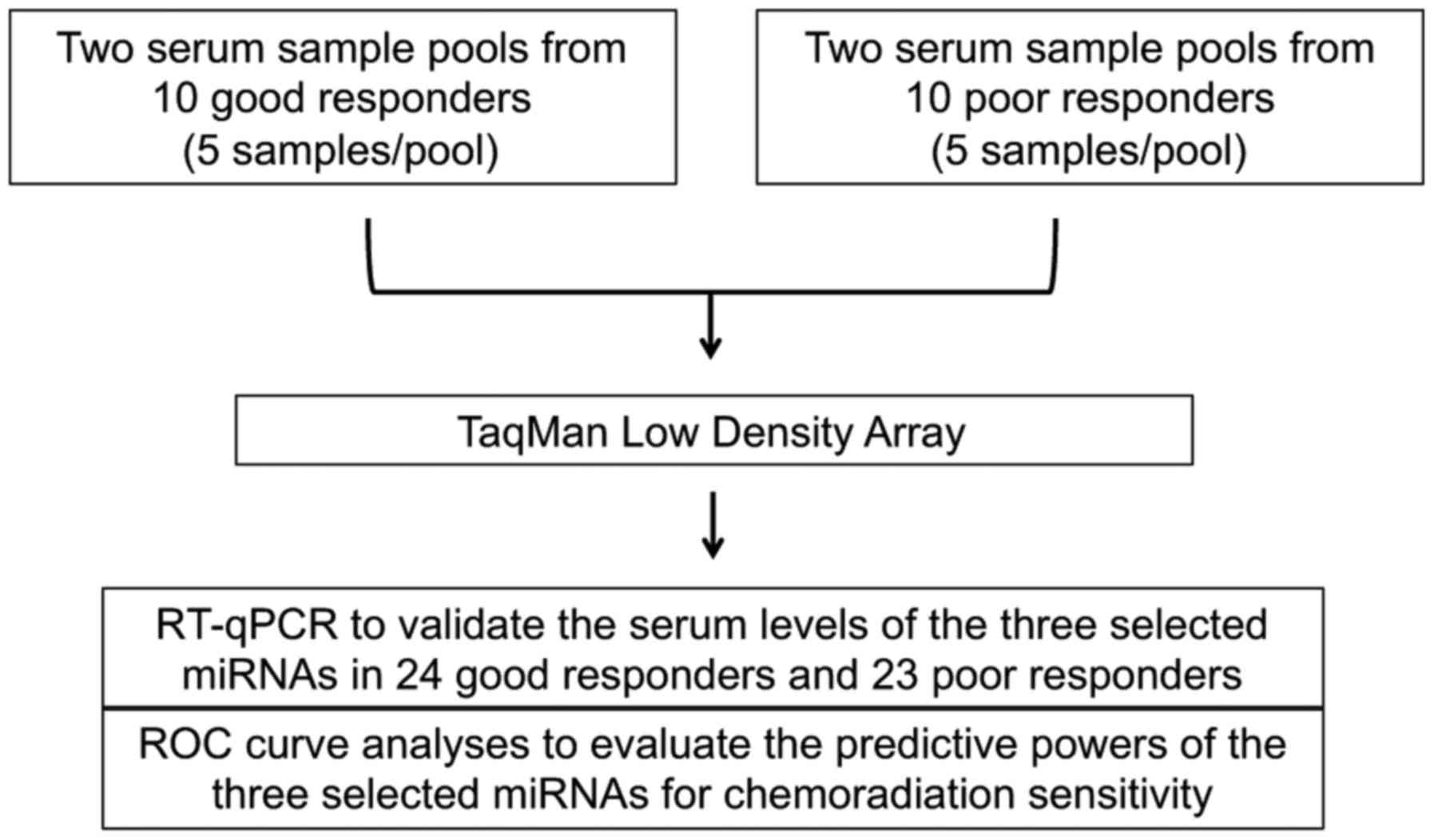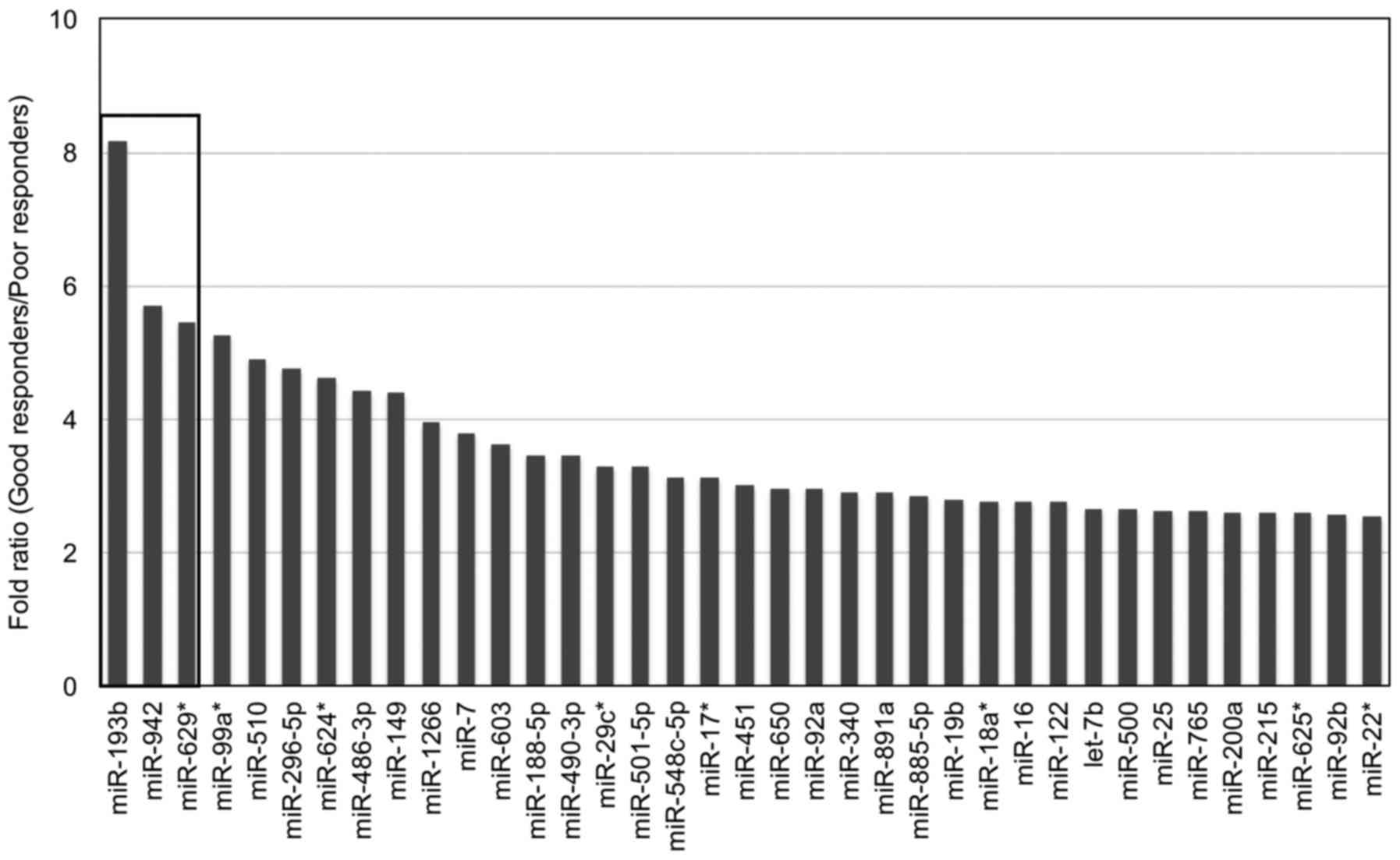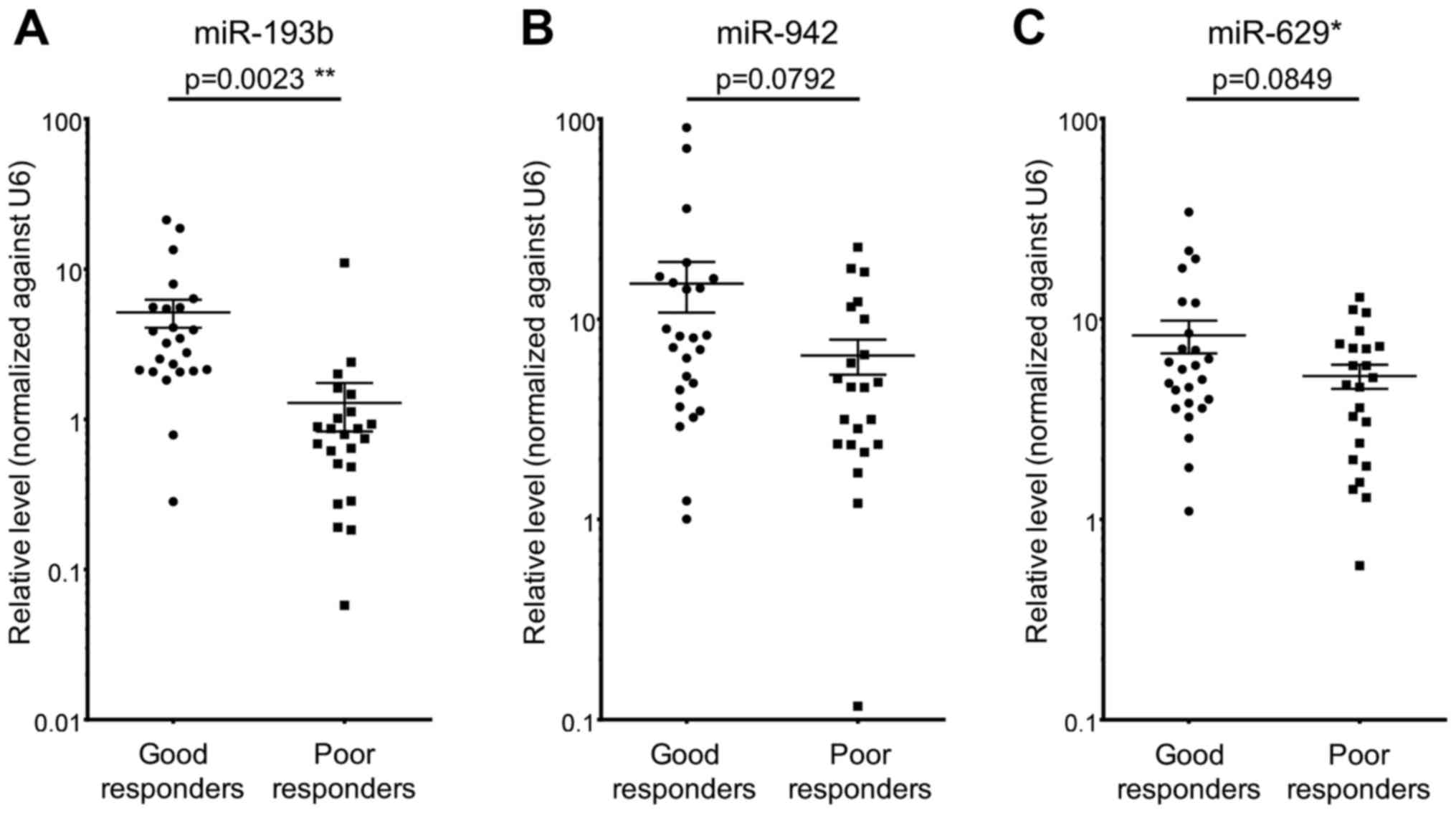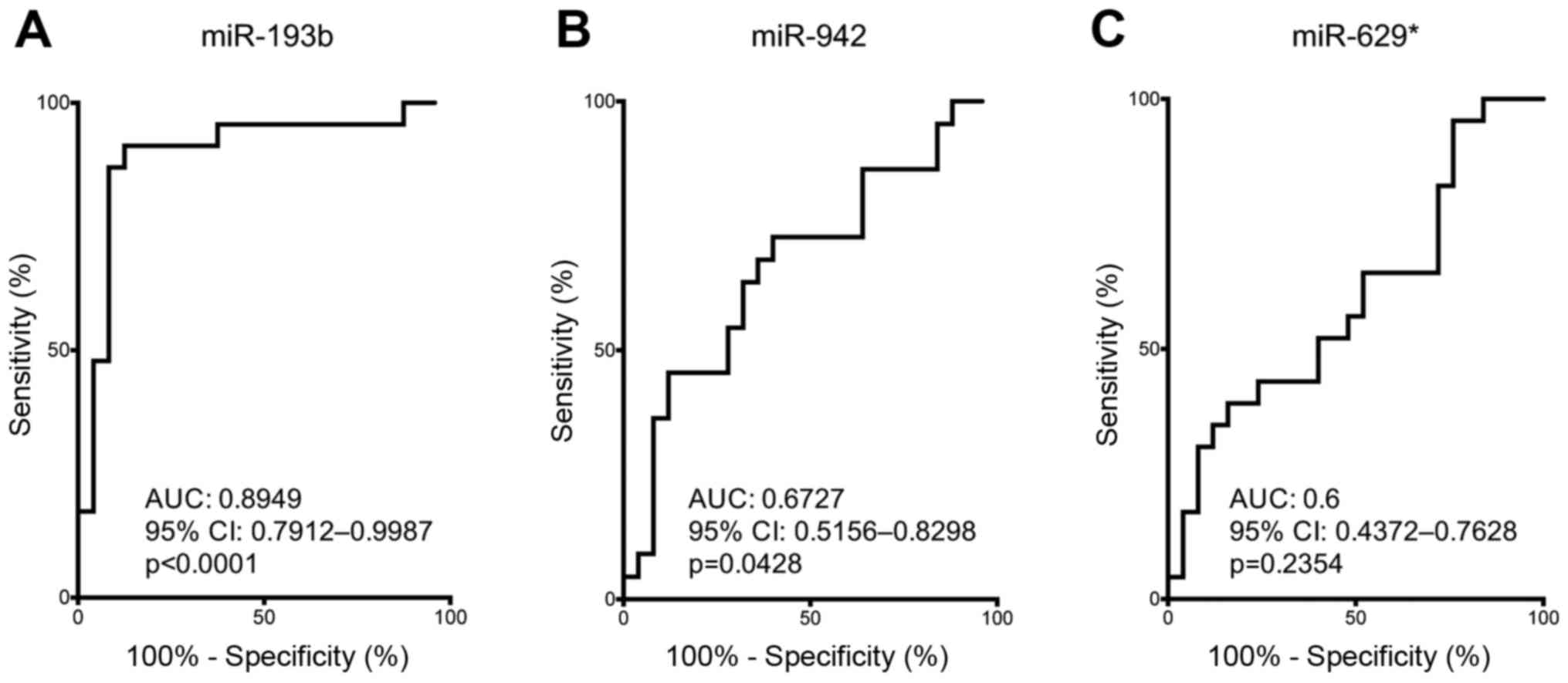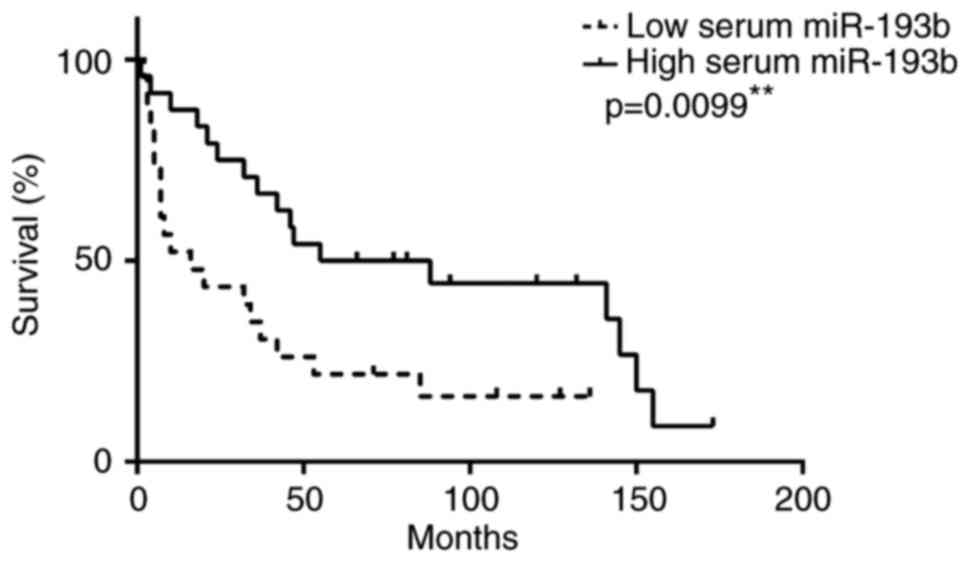|
1
|
Jemal A, Bray F, Center MM, Ferlay J, Ward
E and Forman D: Global cancer statistics. CA Cancer J Clin.
61:69–90. 2011. View Article : Google Scholar : PubMed/NCBI
|
|
2
|
Enzinger PC and Mayer RJ: Esophageal
cancer. N Engl J Med. 349:2241–2252. 2003. View Article : Google Scholar : PubMed/NCBI
|
|
3
|
Hiyama T, Yoshihara M, Tanaka S and
Chayama K: Genetic polymorphisms and esophageal cancer risk. Int J
Cancer. 121:1643–1658. 2007. View Article : Google Scholar : PubMed/NCBI
|
|
4
|
Tong DK, Law S, Kwong DL, Wei WI, Ng RW
and Wong KH: Current management of cervical esophageal cancer.
World J Surg. 35:600–607. 2011. View Article : Google Scholar : PubMed/NCBI
|
|
5
|
Law S, Kwong DL, Kwok KF, Wong KH, Chu KM,
Sham JS and Wong J: Improvement in treatment results and long-term
survival of patients with esophageal cancer: Impact of
chemoradiation and change in treatment strategy. Ann Surg.
238:339–348. 2003.PubMed/NCBI
|
|
6
|
Allum WH, Blazeby JM, Griffin SM,
Cunningham D, Jankowski JA and Wong R; Association of Upper
Gastrointestinal Surgeons of Great Britain and Ireland, the British
Society of Gastroenterology and the British Association of Surgical
Oncology, : Guidelines for the management of oesophageal and
gastric cancer. Gut. 60:1449–1472. 2011. View Article : Google Scholar : PubMed/NCBI
|
|
7
|
Di Leva G, Garofalo M and Croce CM:
MicroRNAs in cancer. Annu Rev Pathol. 9:287–314. 2014. View Article : Google Scholar : PubMed/NCBI
|
|
8
|
Mostert B, Sieuwerts AM, Martens JW and
Sleijfer S: Diagnostic applications of cell-free and circulating
tumor cell-associated miRNAs in cancer patients. Expert Rev Mol
Diagn. 11:259–275. 2011.PubMed/NCBI
|
|
9
|
Garofalo M, Leva GD and Croce CM:
MicroRNAs as anti-cancer therapy. Curr Pharm Des. 20:5328–5335.
2014. View Article : Google Scholar : PubMed/NCBI
|
|
10
|
Tumilson CA, Lea RW, Alder JE and Shaw L:
Circulating microRNA biomarkers for glioma and predicting response
to therapy. Mol Neurobiol. 50:545–558. 2014. View Article : Google Scholar : PubMed/NCBI
|
|
11
|
Schwarzenbach H: The potential of
circulating nucleic acids as components of companion diagnostics
for predicting and monitoring chemotherapy response. Expert Rev Mol
Diagn. 15:267–275. 2015. View Article : Google Scholar : PubMed/NCBI
|
|
12
|
Chen X, Xu Y, Liao X, Liao R, Zhang L, Niu
K, Li T, Li D, Chen Z, Duan Y and Sun J: Plasma miRNAs in
predicting radiosensitivity in non-small cell lung cancer. Tumour
Biol. 37:11927–11936. 2016. View Article : Google Scholar : PubMed/NCBI
|
|
13
|
DAngelo E, Fassan M, Maretto I,
Pucciarelli S, Zanon C, Digito M, Rugge M, Nitti D and Agostini M:
Serum miR-125b is a non-invasive predictive biomarker of the
pre-operative chemoradiotherapy responsiveness in patients with
rectal adenocarcinoma. Oncotarget. 7:28647–28657. 2016.PubMed/NCBI
|
|
14
|
Wen J, Luo K, Liu H, Liu S, Lin G, Hu Y,
Zhang X, Wang G, Chen Y, Chen Z, et al: MiRNA expression analysis
of pretreatment biopsies predicts the pathological response of
esophageal squamous cell carcinomas to neoadjuvant
chemoradiotherapy. Ann Surg. 263:942–948. 2016. View Article : Google Scholar : PubMed/NCBI
|
|
15
|
Hoy AM and Buck AH: Extracellular small
RNAs: What, where, why? Biochem Soc Trans. 40:886–890. 2012.
View Article : Google Scholar : PubMed/NCBI
|
|
16
|
Jarry J, Schadendorf D, Greenwood C, Spatz
A and van Kempen LC: The validity of circulating microRNAs in
oncology: Five years of challenges and contradictions. Mol Oncol.
8:819–829. 2014. View Article : Google Scholar : PubMed/NCBI
|
|
17
|
Cortez MA, Bueso-Ramos C, Ferdin J,
Lopez-Berestein G, Sood AK and Calin GA: MicroRNAs in body
fluids-the mix of hormones and biomarkers. Nat Rev Clin Oncol.
8:467–477. 2011. View Article : Google Scholar : PubMed/NCBI
|
|
18
|
Tong DK, Law S, Kwong DL, Chan KW, Lam AK
and Wong KH: Histological regression of squamous esophageal
carcinoma assessed by percentage of residual viable cells after
neoadjuvant chemoradiation is an important prognostic factor. Ann
Surg Oncol. 17:2184–2192. 2010. View Article : Google Scholar : PubMed/NCBI
|
|
19
|
Liu AM, Yao TJ, Wang W, Wong KF, Lee NP,
Fan ST, Poon RT, Gao C and Luk JM: Circulating miR-15b and miR-130b
in serum as potential markers for detecting hepatocellular
carcinoma: A retrospective cohort study. BMJ Open. 2:e0008252012.
View Article : Google Scholar : PubMed/NCBI
|
|
20
|
Liu AM, Xu Z, Shek FH, Wong KF, Lee NP,
Poon RT, Chen J and Luk JM: miR-122 targets pyruvate kinase M2 and
affects metabolism of hepatocellular carcinoma. PLoS One.
9:e868722014. View Article : Google Scholar : PubMed/NCBI
|
|
21
|
Tsang FH, Au V, Lu WJ, Shek FH, Liu AM,
Luk JM, Fan ST, Poon RT and Lee NP: Prognostic marker microRNA-125b
inhibits tumorigenic properties of hepatocellular carcinoma cells
via suppressing tumorigenic molecule eIF5A2. Dig Dis Sci.
59:2477–2487. 2014. View Article : Google Scholar : PubMed/NCBI
|
|
22
|
Livak KJ and Schmittgen TD: Analysis of
relative gene expression data using real-time quantitative PCR and
the 2(-Delta Delta C(T)) Method. Methods. 25:402–408. 2001.
View Article : Google Scholar : PubMed/NCBI
|
|
23
|
Sun S, Poon RT, Lee NP, Yeung C, Chan KL,
Ng IO, Day PJ and Luk JM: Proteomics of hepatocellular carcinoma:
Serum vimentin as a surrogate marker for small tumors (<or=2
cm). J Proteome Res. 9:1923–1930. 2010. View Article : Google Scholar : PubMed/NCBI
|
|
24
|
Berger AC, Farma J, Scott WJ, Freedman G,
Weiner L, Cheng JD, Wang H and Goldberg M: Complete response to
neoadjuvant chemoradiotherapy in esophageal carcinoma is associated
with significantly improved survival. J Clin Oncol. 23:4330–4337.
2005. View Article : Google Scholar : PubMed/NCBI
|
|
25
|
Stahl M, Stuschke M, Lehmann N, Meyer HJ,
Walz MK, Seeber S, Klump B, Budach W, Teichmann R, Schmitt M, et
al: Chemoradiation with and without surgery in patients with
locally advanced squamous cell carcinoma of the esophagus. J Clin
Oncol. 23:2310–2317. 2005. View Article : Google Scholar : PubMed/NCBI
|
|
26
|
Bonnetain F, Bouché O, Michel P, Mariette
C, Conroy T, Pezet D, Roullet B, Seitz JF, Paillot B, Arveux P, et
al: A comparative longitudinal quality of life study using the
Spitzer quality of life index in a randomized multicenter phase III
trial (FFCD 9102): Chemoradiation followed by surgery compared with
chemoradiation alone in locally advanced squamous resectable
thoracic esophageal cancer. Ann Oncol. 17:827–834. 2006. View Article : Google Scholar : PubMed/NCBI
|
|
27
|
Tanaka K, Mohri Y, Ohi M, Yokoe T, Koike
Y, Morimoto Y, Miki C, Tonouchi H and Kusunoki M: Excision-repair
cross-complementing 1 predicts response to cisplatin-based
neoadjuvant chemoradiotherapy in patients with esophageal squamous
cell carcinoma. Mol Med Rep. 2:903–909. 2009. View Article : Google Scholar : PubMed/NCBI
|
|
28
|
Duong C, Greenawalt DM, Kowalczyk A,
Ciavarella ML, Raskutti G, Murray WK, Phillips WA and Thomas RJ:
Pretreatment gene expression profiles can be used to predict
response to neoadjuvant chemoradiotherapy in esophageal cancer. Ann
Surg Oncol. 14:3602–3609. 2007. View Article : Google Scholar : PubMed/NCBI
|
|
29
|
Wen J, Yang H, Liu MZ, Luo KJ, Liu H, Hu
Y, Zhang X, Lai RC, Lin T, Wang HY and Fu JH: Gene expression
analysis of pretreatment biopsies predicts the pathological
response of esophageal squamous cell carcinomas to
neo-chemoradiotherapy. Ann Oncol. 25:1769–1774. 2014. View Article : Google Scholar : PubMed/NCBI
|
|
30
|
Hemmatzadeh M, Mohammadi H, Jadidi-Niaragh
F, Asghari F and Yousefi M: The role of oncomirs in the
pathogenesis and treatment of breast cancer. Biomed Pharmacother.
78:129–139. 2016. View Article : Google Scholar : PubMed/NCBI
|
|
31
|
Kurashige J, Kamohara H, Watanabe M,
Tanaka Y, Kinoshita K, Saito S, Hiyoshi Y, Iwatsuki M, Baba Y and
Baba H: Serum microRNA-21 is a novel biomarker in patients with
esophageal squamous cell carcinoma. J Surg Oncol. 106:188–192.
2012. View Article : Google Scholar : PubMed/NCBI
|
|
32
|
Tanaka K, Miyata H, Yamasaki M, Sugimura
K, Takahashi T, Kurokawa Y, Nakajima K, Takiguchi S, Mori M and
Doki Y: Circulating miR-200c levels significantly predict response
to chemotherapy and prognosis of patients undergoing neoadjuvant
chemotherapy for esophageal cancer. Ann Surg Oncol. 20 Suppl
3:S607–S615. 2013. View Article : Google Scholar : PubMed/NCBI
|
|
33
|
Maher SG, McDowell DT, Collins BC, Muldoon
C, Gallagher WM and Reynolds JV: Serum proteomic profiling reveals
that pretreatment complement protein levels are predictive of
esophageal cancer patient response to neoadjuvant chemoradiation.
Ann Surg. 254:809–817. 2011. View Article : Google Scholar : PubMed/NCBI
|
|
34
|
Hsu FM, Cheng JC, Chang YL, Lee JM, Koong
AC and Chuang EY: Circulating mRNA profiling in esophageal squamous
cell carcinoma identifies FAM84B as a biomarker in predicting
pathological response to neoadjuvant chemoradiation. Sci Rep.
5:102912015. View Article : Google Scholar : PubMed/NCBI
|
|
35
|
Nyhan MJ, ODonovan TR, Boersma AW, Wiemer
EA and McKenna SL: MiR-193b promotes autophagy and non-apoptotic
cell death in oesophageal cancer cells. BMC Cancer. 16:1012016.
View Article : Google Scholar : PubMed/NCBI
|
|
36
|
Chen J, Zhang X, Lentz C, Abi-Daoud M,
Paré GC, Yang X, Feilotter HE and Tron VA: miR-193b regulates Mcl-1
in melanoma. Am J Pathol. 179:2162–2168. 2011. View Article : Google Scholar : PubMed/NCBI
|
|
37
|
Mao K, Zhang J, He C, Xu K, Liu J, Sun J,
Wu G, Tan C, Zeng Y, Wang J and Xiao Z: Restoration of miR-193b
sensitizes Hepatitis B virus-associated hepatocellular carcinoma to
sorafenib. Cancer Lett. 352:245–252. 2014. View Article : Google Scholar : PubMed/NCBI
|















